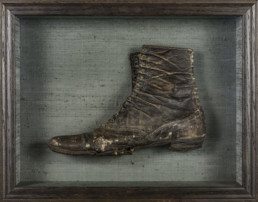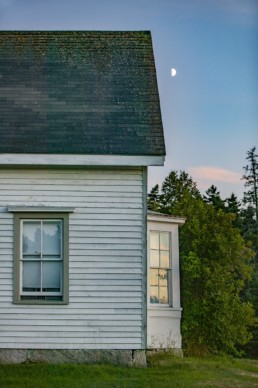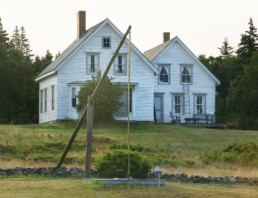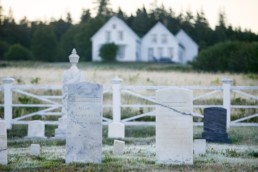The Secret Soul of an Island Shoe
Was it a talisman warding off evil spirits?
A replicated ritual from across the Atlantic?
By CHRISTINA MARSDEN GILLIS
PHotos By Peter Ralston
Its sole gouged with holes, the leather top cracked and ripped, the shoe, a woman’s, had been hidden in the west wall of an upstairs bedroom in our Gotts Island house.
Nestled behind the plaster, it had endured Maine winters when the winds howled out of the north, and warm summer days when the bay to the west glowed brilliantly blue. It would have occupied the house alongside generations of families, our own only one in a line that included Gotts and Moores, descendants of the original island settlers.
I know the island, named for its founder Daniel Gott. And I know the house because I have spent every summer of my adult life in it. But I do not know the story the shoe may tell. No one lives year-round on Gotts Island now, the permanent community founded in 1789 having left by 1930. Through the long winter months, when I have returned to my home in California, our house, locked and shuttered like all its neighbors, holds on to the knowledge contained in the shoe.
It had been hiding in the wall for about 140 years, a secret sharer in a house that I thought, at least for the past 50 years, belonged entirely to my family and me. Earlier owners—A.J. Gott, Philip and Vinie Moore—have a reality I can understand. Their passing on the house to us is codified in legal documents. The shoe is different, its possession opaque and somehow the stronger for that.
It is both a witness to history, and a part of history itself. But it is a clouded history as well. In trying to pursue it I would only discover—as with so many other aspects of a small remote island—how much we do not, and cannot, know. This may be the lesson, difficult as it is, that the shoe ultimately has to teach.
Information provided by an architectural preservationist was concrete and direct, inspiring of confidence: “When renewing walls especially around windows and doors…(owners of 18th or 19th century houses) should be aware of the possibility of turning up concealed shoes.” If your contractor finds one, the preservationist cautioned, tell him or her not to throw it out.
This sounded as if people were finding shoes in walls every day. But certainly Adam Sawyer had never heard of it when he was installing new windows and unearthed the shoe in the wall of the bedroom over the kitchen. Fortunately, he did not throw it out. This strange unfathomable presence came into our lives as a kind of ritual object.

On a warm evening in August, my son and his family, my husband, and I gathered ourselves in a circle around an old cane-seated chair on which, like a talisman object, sat the shoe. The aim of the exercise was story making. If we didn’t have any facts, at least, under the power of the object itself, we could imagine its story and how it came to be in the wall.
But imagination is not enough. Once back at my computer in California, I mined Google for still more information on concealed shoes. I learned that in Northampton, England, once a major shoe manufacturing site, similar stories had come to light. In the Northampton Museum resides an index of now more than 2,000 shoe findings, a project begun in the mid-20th century by a curator named June Swann. Most of Swann’s examples came from the UK, but other European countries, Canada, and the United States are also represented. The earliest case is a shoe found in the choir stalls of Winchester Cathedral in 1308.
Interestingly, Swann, who was decorated by Queen Elizabeth in 1976 for her work, found that the number of concealments tended to rise and fall in sync with historical events, rising in times when political or other disruption would have increased anxiety and stress in a community: the Revolution of 1688, or the Thirty Years War in Europe, for example. With this in mind she concluded that the concealed shoe must have been thought of as protecting a building or household against whatever negative forces—political, natural, or supernatural—might threaten it.
But Swann, like other researchers, was never able to find a concrete written explanation to substantiate her theory. Shoes must have sat, unremarked, some for hundreds of years, concealed in chimney spaces, walls, and floorboards. They turned up in humble cottages as well as grand manor houses and palaces, in a Baptist chapel (as well as Winchester Cathedral), in two Oxford colleges, and in hospitals and workhouses.
As for North America, the Society for the Preservation of New England Antiquities has records of more than 100 concealed shoes, the majority in Massachusetts. Examples date from the end of 18th century to as late as 1916, with the larger numbers found in the period 1830-1860. But the most striking to me were the shoe discoveries in Gloucester and its immediate environs—Gloucester was the original home of many of the families, including the Gotts, who were to arrive on Mount Desert Island in the 18th century.
Here were the outlines of a trail, but I had not reached its beginning.
The Gott family represented a pattern. The first Gott to arrive on North American shores with John Endecott in 1628 was Charles, the great grandfather of Daniel, who in 1789 would purchase Gotts Island for 18 pounds. As we know from the work of historians such as David Hackett Fischer, Gott and his fellow settlers would have brought with them not only place names but, more importantly, cultural practices and beliefs they had known in the region they had left behind.
Now I was tracking, if not the shoe itself, the idea that may have given rise to its appearance in our bedroom wall. Like most of the early settlers in Massachusetts, Charles Gott probably came from East Anglia, which, according to the Newcastle index, is the site of many concealed shoe discoveries.
The mindset of those 17th century Protestants poses a challenge to the imagination, but we know they were highly superstitious people. They probably would not have used that term; they would have spoken of “wonders” wrought by God: heads without bodies, animals changing shape, objects suddenly moving by their own agency.
Religion and superstition went hand in hand for these Puritan believers. Witches were as real in Massachusetts as they had been in East Anglia, which saw the greatest concentration of recorded cases of witchcraft in Britain. If we consider that East Anglia is also known for its high incidence of shoe findings, it seems that shoe concealment and belief in witches may have traveled together to the New World, the former, presumably, a protective device for confronting the supernatural power of the latter.
Still, as June Swann had found, a penumbra of secrecy surrounds the practice. Archaeologist Ralph Merrifield, in The Archaeology of Ritual and Magic, notes that no evidence of shoe concealment was recorded by the avid collectors of folklore in the 19th century, even where the practice was clearly still flourishing. The closest Merrifield can come is to call up an “unofficial” English saint named John Schorn, a parish priest in Buckinghamshire, who was famous for his so-called capacity to entice the devil into a boot; hence, to protect the household against witches or other evil presences, one could be advised to place the boot (or shoe?) near a point of entry like a window or door where it would act as a trap. It’s a plausible theory. And it’s a good story too.
But there’s nothing concrete about such stories. And what was true in Britain applies to the United States as well. We have lore involving shoes, but not shoes hidden in walls.

In “Jonathan Moulton and the Devil,” a tale included in John Greenleaf Whittier’s Home Ballads, for example, the central character makes a pact with the devil who appears from out of the chimney and offers to fill Moulton’s boots with gold coins if he places them in the chimney. The story—the deal does not work out for Moulton, of course—includes three elements of possible relevance to the shoe ritual: boots (shoes), the devil, and a chimney (a common location for shoe discoveries). But still, bits and pieces do not add up to a complete picture.
~
The realm of belief, magic, and superstition is difficult to penetrate. We can only try to follow practices that travel in both time and space, undergoing various metamorphoses along the way. The route from East Anglia in the 17th century to a small community on Gotts Island, Maine, in the 19th, is circuitous, even unexpected. It is
never clear.
I was discovering what the Federal Writers’ Project of the WPA (Works Progress Administration) had already found in its 1937 volume on Maine (Maine: A Guide ‘Down East’). In a brief chapter titled “Folklore and Folkways,” it points out that the “comparative isolation and independence of many a ‘down-East’ community have helped to preserve … old customs, beliefs, and legends … that hark back to the Elizabethan times.” These tales of sea serpents, haunted houses, ghosts, and witches had not sprung into being spontaneously. If therapeutic magic practiced throughout Maine in 1937 still was believed to have some efficacy, it also had a long history.
Nor did the federal writers—perhaps thinking back to those early seventeenth-century Protestants?—discount the possible connections between superstition and religious belief: “Every year,” they point out, “serious church-going people attest to the truth of such mysteries and monsters, and an almost limitless volume of material could be gathered about them.”
Itinerant preachers in the 19th century worked to keep religious belief alive and strong on Maine’s offshore islands. The Rev. Lemuel Norton had, for a time, a modicum of success in converting Gotts Islanders to his brand of Free Will Baptists, but it is his description of his arrival on the island, probably in the 1830s, that I find particularly telling.
“When I stepped off the boat,” Norton wrote, “I felt as though I could hardly endure the loneliness of the place.” If religion and superstition go together, as the federal writers suggested, the connection is reinforced by the relative isolation of a community.
In arriving at Gotts Island, Norton stepped ashore on a “beautiful spot of God’s earth,” a place “surrounded by the mighty deep”; but the sea, “mighty deep,” was the real threat—more dangerous than witches—that the islanders, like all coastal people, would have faced.

Understandably, the unpredictability of natural forces, particularly those of the sea, supports superstitious belief. Where livelihoods depended upon fishing, the mythical sea serpents and other creatures that the federal writers heard about most likely represented a response to the dangers, and the fears, posed by the sea itself. Gotts Island’s first Gott, Daniel, and two of his sons were drowned while fishing near Mount Desert Rock in 1814; the small cemetery on Gotts Island attests to how many others met a similar fate.
The sea, the weather, and the currents that determine its actions had to have been inextricably linked to the lives of the intermarried Gott and Moore families who inhabited our Gotts Island house. Susannah Gott’s diary, written in the 1850s, almost obsessively records weather and wind conditions that would have influenced the fishing community and its dependence on the sea. Our house looks westward, out to the sea; the shoe had been hidden by the upstairs window that offers the most encompassing view. It is as if it had been looking out, watching over the safety of the family members who worked that sea.
~
But who could have put “our” shoe in that wall? If I knew that, would I be any closer to knowing why? When I mentioned our strange find to Muriel Trask Davisson, a retired Jackson Lab scientist who now administers the local Bass Harbor Museum, she told me that other shoes had been found in Tremont, the mainland township to which Gotts Island and Bass Harbor belong (I later learned, in a recent article by local archaeologist Anne Grulich, that no less than 14 had been discovered on nearby Cranberry Island). Muriel didn’t have details but remembered talk in her own family of a shoe’s having turned up in the Trask house in Bass Harbor. She said a carpenter named Babbidge had worked on that house.
Here was another thread, this one closer to home. I had a name, perhaps not the right one, but at least a name. On the “Colby Map of Gotts Island” (created in 1879), our house is identified as the home of A.J. Gott, and the closest neighbor, the dwelling immediately to the north, as that of Martin Van Buren Babbidge. The Annual Register for the State of Maine for 1889 lists one M.V. Babbidge, resident on Gotts Island, as “carpenter.” Like A.J. Gott, Babbidge was a man of many occupations (one of which was as undertaker, another as lay minister who performed various marriages on Gotts Island). He had lived on neighboring Swan’s Island for the earlier part of his life, but by 1879, as made clear on the Colby map, he was settled on Gotts Island. I see the house, still there, as a mirror image of ours—at least before ours gained its addition that includes the bedroom in whose exterior wall our contractor found the shoe.
If M.V. Babbidge built or rehabbed a house in Bass Harbor in which a shoe was also found, and if—as seems possible—he was involved in the construction of our addition (or even, according to one theory, moving and putting in place a structure that became the addition), then it seems possible also that it was he who placed the shoe in the wall. He would have been enacting what has been called simply a “builder’s ritual,” a superstition that presumably draws, however tangentially, on the belief that goes back to the 14th century in England.
But who knows, really, whether Babbidge, in any conscious way, was acting to protect the household from some negative fate? Perhaps he wasn’t thinking at all; putting a shoe in the wall was just “something one did.”
Still, despite the unknowns, having the name of a real person (right or wrong) who may have been directly involved in the mystery, lent concreteness to the shoe itself and, even more important, to the woman whose foot is traced in its cracks and creases. Of all articles of clothing, the shoe most strikingly represents the presence, even the spirit, of the individual who wore it. This shoe connected a human physical body to the earth. There is something of the uncanny in our not knowing whose body it was, whose trace we are witnessing. But one thing we know for sure: if there is power embedded in this shoe, it is the power of a woman.
A woman presided over the domestic space of our house, a woman charged with the protection of her family. Beyond the reach of the treacherous sea, so clearly in view from the kitchen window, the house, part of a village that spread in a jagged line along the westward-facing hillside of the island, stood secure.
Here was the woman’s place. Hers was not a household that included non-family members, servants, or slaves (concealed shoes are rarely found in such homes in the U.S.). Whether Gotts or Moores, a nuclear family occupied our house.
On the night our family sat in a circle and tried to imagine the history of the shoe sitting on the chair before us, we were attempting to recreate that woman and her life on Gotts Island in a time so distant from ours. We studied the shape, narrow and slightly pointed—a slim foot it must have been—and we thought that it still retained, despite its desperate condition, a kind of elegance. Yes, it was badly worn, but that is typical of found shoes. Shoes were highly valuable articles of clothing, well taken care of, and intended to last, even for generations. No one would willfully dispose of a good shoe. Perhaps our shoe had been worn only for church going on Sundays, consigned to its hiding place in the wall only after years of wear.
On the other hand, there is a prosaic, almost domesticated quality to the shoe. In a version of a putting-out system, shoes were often constructed, after all, in a domestic space: they belong both in, and to, a house. They knew both the toil of a household and its more celebratory moments.
As for the actual life of the woman who wore the shoe, I expect that I, like June Swann at the Northampton museum, will find no diaries or letters, no specific, real-life, references to who she was or why her shoe was concealed in a wall; and the narrative offered by history, myth, and folklore will always be incomplete. But if our family’s attempts to reconstruct her story were little more than uninformed responses, there are other, more reliable, stories that evoke a local place and provide a more reliable view of the lives experienced there.
Ruth Moore (1903-1989), the most famous member of the family who occupied our house from 1899 until the exodus in 1930, was born and spent her childhood and youth on Gotts Island, and went on to become its chronicler in poetry and prose. Her fictional accounts of life lived in what I envision as my own house in the early decades of the 20th century open up a world that saw power in a woman’s shoe. I see the woman of the family, in whatever shoes she is wearing, standing before the Empress Atlantic wood stove, peering out the kitchen windows to the cemetery down the hill and the ocean beyond, perhaps thinking of family and fellow islanders whose graves she can almost see. Fictions give us individual people who seem “real”: the element that neither June Swann nor I could find in historical theory
or lore.

That Ruth Moore does not write about shoes in walls—probably had no idea that the shoe was there—doesn’t really matter: she gives us a place in which an act like concealing a shoe may have happened. In, for example, The Weir, a struggling family is torn between remaining on the island they have always known or joining neighbors who are leaving to seek a better, and perhaps safer, life on the mainland.
Though the father exerts great effort to support his family and maintain the weir—a netted device strung along a tidal area for catching herring—the major presence in the kitchen, protector of the family order and heart of the house, is Josie, the mother. The men’s territory is elsewhere, a slapped-up structure by the shore to which they repair to socialize, build lobster traps, paint buoys, and store gear and bait—and not be in their wives’ kitchens.
In the words of a local sage quoted in the novel, the men’s gathering spot is “nothing but a damn frig, and the first good gale would blow it down.” A real island house has “laths and plaster and an upstairs and at least two gables, and was built by local labor at the going prices.” Was Ruth thinking of M.V. Babbidge, who would have been still living in her early childhood? This is the space overseen by Josie; this is the house that Ruth Moore knew, the house that a woman’s shoe protects.
Our shoe did not belong to Josie, or, given the time frame, to Vinie, Ruth Moore’s mother on whom aspects of the fictional mother must have been based. I do not know who wore that shoe: perhaps A.J. Gott’s wife Caddie, perhaps M.V. Babbidge’s wife Susan. Or another person entirely. To this degree, the shoe is an object that belonged to itself in its own space; it transcended ownership. And once removed from its hiding place in the bedroom wall to join our world, it became a still different thing, subject to whatever context we wished to give it.
At the end of the summer, our son Chris took the shoe to his home in San Antonio, Texas, to have it framed and preserved. When next we saw it, it was encased in a finely crafted box, affixed to sage green raw silk that brings out the color in the grommets through which the unknown woman would have pulled up the laces.
In a sense, it had been transformed from magic to art. Its “spirit” is now controlled, no longer inspiring the kind of anxiety that I recall feeling last summer. But if this means that something has been lost—and I think it does—I still have a story, or more accurately, stories to tell. And I am comfortable with that.
Christina Marsden Gillis lives in sight of two oceans: in Berkeley, California., it is the Pacific; at Gotts Island, it’s Blue Hill Bay and the islands. With a PhD. in English, Gillis taught and published in the field of 18th-century literature before moving into humanities administration at the University of California at Berkeley.






